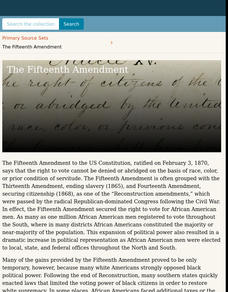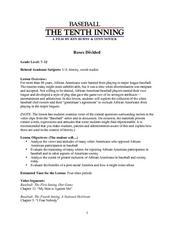PBS
Hidden Messages in Spirituals
Slaves laboring in the cotton fields of the old South singing joyously may have convinced overseers that their workforce was happy and content, but in truth, these spirituals contained secret codes. After viewing a short video about...
Digital Public Library of America
The Fifteenth Amendment
Fifteen primary sources provide a context for a study of the Fifteenth Amendment to the United States Constitution. The packet captures the excitement for the changes promised by the amendment as well as the backlash against it.
Center for History Education
Slavery and Civil Disobedience: Christiana Riot of 1851
When is it a moral obligation to disobey the law or to fight back? Using primary sources that document the "Christiana Riot" of 1851, learners consider these questions. The firsthand accounts tell the story of the riot, which happened...
Alabama Department of Archives and History
Beyond Birmingham, Summer 1963
The assassination of Medgar Evers. The integration of the University of Alabama. The March on Washington. The "I Have a Dream" speech. Created by the Alabama History Education Initiative, this resource examines how the events that...
National Park Service
Lesson 4: Escape
Some enslaved people decided to run for their liberation. Using lyrics of songs they sang, young historians look at these anthems of freedom. An assessment asks them to write the story of escape from the perspective of an enslaved person.
Anti-Defamation League
Rosa Parks: Sources of Information
Young scholars show what they know about Rosa Parks and the incident on one of the buses in Montgomery, Alabama. Groups discuss and identify where they receive most of their information. They examine the importance of having a complete...
C3 Teachers
Reparations: Why Are Reparations Controversial?
To understand why the topic of reparations is controversial, young scholars gather background information by reading articles, watching videos, and examining cases where reparations were made. Learners consider the lasting repercussions...
C3 Teachers
Civil Rights: What Made Nonviolent Protest Effective during the Civil Rights Movement?
Sit-ins and boycotts, marches and speeches, songs and demonstrations were hallmarks of nonviolent protest of the civil rights movement. Young scholars research primary and secondary source documents to determine what made nonviolent...
C3 Teachers
Anna - One Woman’s Quest for Freedom: What Did Freedom Mean for Anna?
The 2018 film Anna, One Woman's Quest for Freedom in Early Washington, D.C., offers high schoolers an opportunity to examine the sacrifices one woman endured to gain her freedom from slavery.
National Constitution Center
Voting Rights since the Fifteenth Amendment
What does it mean to have the right to vote? To what extent have interpretations of the Fifteenth Amendment changed over time? Young historians examine and analyze primary source documents, an interactive website, and historical analysis...
Curated OER
Social Effects of WWII on SC
Fourth graders compare how the events in the Charleston Harbor affected South Carolinians versus people in other parts of the U.S. In this American history lesson, 4th graders watch a video clip, discuss sections of a book, and conduct...
Curated OER
OK in Oklahoma? All-Black Communities
High schoolers read a narrative on western migration. They examine the early segregation laws adopted at the time of Oklahoma statehood, and weigh the advantages and disadvantages of single-race communities.
Curated OER
City Upon a Hill: Urban Centers and African-American Migrants
Students examine why fugitive slaves migrated to cities and towns rather than rural areas. In this lesson, students consider the social, economic, and political benefits provided by cities and towns in comparison to rural areas.
National Woman's History Museum
Sally Hemings: Raising a Family Amidst the Brutality of Slavery
Pupils may know about early American figures such as Phyllis Wheatley and Abigail Adams, but what about Sally Hemings? Sally Hemings was the mother of Thomas Jefferson's children, but she is often left in the shadows of history....
Curated OER
Her stories: African American folktales, fairy tales, and true tales
Students discuss the illustration's allusion to the myth, Pandora's Box. Students locate instances of folk sayings or expressions that make these tales seem authentic to the reader. Students draw a Venn diagram comparing Catskinella and...
Curated OER
An Experiment in Unfair Treatment/Prejudice
A rigged spelling bee gives class members a chance to experience some of the feelings associated with unfair treatment. Team one is given easy words while team two is given difficult words. As teams realize the unfairness the instructor...
Curated OER
Look for Patterns: Quilts in Two Faith Ringgold Stories
Author Faith Ringgold uses quilts to illustrate her books Tar Beach and Aunt Harriet's Underground Railroad. In this integrated trio of activities, young scholars read stories, identify and create patterns, and design quilt squares of...
Curated OER
Folklore and Oral History
Learners listen to a lecture about the tradition of story telling and oral history. They research three examples of African American and/or Negro Leagues oral tradition. they work in groups of four, and decide on one example from their...
Curated OER
Using Oral Traditions to Improve Verbal and Listening Skills
Students examine the role of stories in African and African-American cultures. This lesson is written for students with visual impairments. They
PBS
Baseball: The Tenth Inning - Bases Divided
Baseball is a relatively high-interest topic through which social studies classes can explore racial prejudice in the US. Video clips provide much of the background information that groups record on their handout and then share with the...
Curated OER
Matthew Henson
Discuss the work of Matthew Henson, an African American who traveled to the North Pole with Robert Peary. After reading the story "Matthew Henson" by Maryann N. Weidt, learners answer questions by drawing inferences and conclusions,...
Curated OER
Black Power
Use this New York Times activity to research contemporary leaders in the African-American community. After reading the article "Blacks Weigh the Impact of the Post-Jackson Years," middle and high schoolers discuss the varying viewpoints...
Curated OER
Spirituals
Students review factors that contributed to the development of the spiritual, which reflects the influence of African religious and Christian traditions, and slavery. Students collect spirituals/songs of their heritage from family...
Curated OER
Kwanzaa Language Arts: The Tambiko
Students read or hear about famous African Americans to learn about the ways in which they exemplify one of the seven principles of Kwanzaa.

























